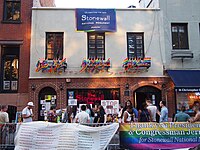
Photo from wikipedia
As new immigrant destinations in the USA have become home to more settled immigrant populations, they are also becoming less male-dominated and attracting more women and families. But this process… Click to show full abstract
As new immigrant destinations in the USA have become home to more settled immigrant populations, they are also becoming less male-dominated and attracting more women and families. But this process is occurring unevenly, with some new destinations much more attractive to women than others. The factors that might lead a destination to attract or retain women are not well understood. We draw on interviews with long-time Latin American residents in a non-metropolitan community in Utah with a fairly high proportion of women immigrants to analyze the ways in which gender and other factors relate to community attachment in this specific context. We examine gender differences in satisfaction with the community and experiences of discrimination and plans to remain in the community. Surprisingly, given current anti-immigrant trends in national politics, we found high levels of community attachment among both men and women. Although experiences of racism were common in our sample, many of the respondents were quick to downplay these experiences and focused instead on their overall positive assessment of the community. Women were more attuned to the experience of discrimination and less willing to downplay it. They were also less likely to have a long-term plan to remain in the community, but this appeared to be more related to their consideration of other family members’ long-term plans, rather than due to their experiences of discrimination. These findings have implications for understanding gendered settlement patterns as well as for promoting immigrant integration at the local level in an unfavorable political context.
Journal Title: Journal of International Migration and Integration
Year Published: 2019
Link to full text (if available)
Share on Social Media: Sign Up to like & get
recommendations!